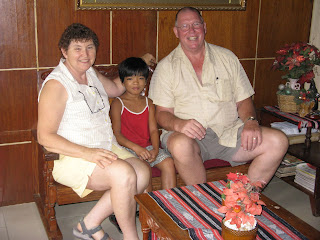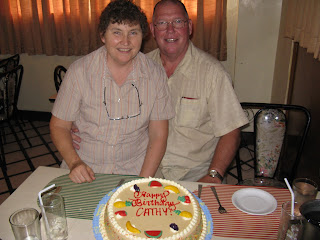Hello Everyone,
As I said we will TRY to update the blog every week-end, however our weekly schedule doesn't always get us back to our home in time to visit our internet source before closing at 5 on Fridays. Internet is still a struggle here...I wish there was a better way.
At least this time I was able to post a few pictures that I should be able to edit but still haven't figured that out. I was hoping to write a few lines between each but that too has slipped my comprehension...oh well I'm sure you'll forgive me.
We've had considerable stressing news from Canada lately. Although we left after Cathy's Mom had bladder surgery to remove a large tumour we have now been informed that it is an agressive terminal cancer that is already affecting her kidneys (one has burst and has to be drained via tube and colostomy). The doctors are hoping the drainage will strengthen the kidneys that radiation may be performed to slow the aggression. The stressful part for Cathy of course is that she is again on the other side of the world like in the spring when her father passed away.
A very close and dear friend of the Vink family, Gerald Kastein, has also passed away this past week. Gerald also had terminal cancer and again although we said our final farewells prior to leaving, it still leaves an emptiness in our lives. Our hearts are sorrowful for the loss to Trudy and all her family.
On the 'home' front here in the Philippines I feel the progression is painstakingly slow but not without hope. I have been assigned to visit an additional 10 municipalities within the province of Isabela, we call them a Local Government Unit or LGU's (kind of like counties in Ontario) in addition to the LGU of San Pablo where we were in March thru May. We spend about 2 days in each first discussing the anemities of the LGU and further the potential of getting local entrepreneurs to start dairy enterprises. We discuss the potential of a new industry locally, provincially and even nationally. Although as you can see from the pictures there are areas outside this province, principally south of Manila, where dairying is occuring to some degree. On the second day we usually do a tour of the LGU especially those areas most conducive to growing forages and milk production.
In our most recent visitation in San Mateo, the Mayor, who was one of the tour participants in September, is a most committed and active supporter of our initiative. This LGU is noticeably progressive under his leadership and offers real hope for a beginning dairy enterprise. We met a 70 year old individual who is currently chairman of a local cooperative, who in 1990 started a dairy operation with holstein cows. In 1995 with the signing of the World Trade agreement, additional milk imports were allowed here that essentially dried up his market. He was adamant that a viable, sustainable market is first and foremost, which is my premise as well.
In a meeting with the National Department of Education I learned that about 20% of school children in this province have below normal growth rates, the highest of all provinces in the Philippines. I was shown statistics that where there was a school milk program these below normal rates declined considerably during a milk feeding program. When children went home for their summer holidays (and probably no milk), upon return to school the below normal rates had again increased. Milk's goodness cannot be denied!
A school fresh milk feeding program supported nationally, provincially and locally is a prime beginning market that would give farmers and processing a chance to find the necessary maintainable volumes in a given area while searching out more permanent markets for increased volumes.
As I mentioned in our last blog further exciting news about future projects has been forthcoming. First of all we have been told that based on the even limited success so far in San Pablo of last May and the success of the reverse engagement in Ontario in September, the Canadian International Development Agency (CIDA) although after many years of support has withdrawn its direct support to the Philippines through CESO, has agreed to a further 5 year support for dairy projects in Northern Luzon. The Regional Director of the Department of Trade and Industry, also a member of the Ontario Tour, is preparing a further re-engagement throughout the 5 Provinces of this Northern Region and suggested that I should be the volunteer point person...quite daunting but also exciting.
Now to describe the pictures a little, beginning at the lowest one on the blog:
1. It is real winter when you fly near the north pole...the shortest distance from Toronto to Manila is over the top of the world. Although it does feel any different still an interesting experience!
2. Our plane in Hong Kong, a 2 hour stop over before the final 1.5 hours to Manila
3. It's now the evening of the second day as we arrive in Manila...actually good for the body clock to be able to go to bed. The body clock seems less affected travelling west as opposed to east.
4. The next morning outside our hotel in a Manila suburb called Mandaluyong. We took a rest day on Wednesday and met a previous acquiantance who picked us up at 4am Thursday to visit dairy farms 2 hours south of Manila in Batangas Province.
5. Who said there weren't dairy farms in the Philippines. These cross breds under a New Zealand style management are producing about 18-20 litre average per day.
6. Baby calves enjoying self feeders already on pasture.
7. Batangas is known for its coconut groves which can be renovated with forages and offer excellent shade with great air movement.
8. Heifers look good under these conditions...essentially unseen in our northern destination.
9. Without forage renovation these coconut groves become jungles of wasteland. I have been using these previous pictures as examples of initiative and potential in Isabela where Mango groves can also be renovated to provide similar success.
10. We visited a trade fair in Tuguegarao, near San Pablo. The Processing Cooperative was promoting their milk products selling about a 100 litres of milk per day during the week long Mall exposition. When I left in May they still were only processing 11 litres per day. Milk is still only coming from backyard 1 & 2 animal farms, left overs from nursing calves and home use...still not a 'dairy industry' but more than it was. We now hear of farmers purchasing cows and breeding them to calve in nine months, etc. Simple progress but PROGRESS!
11. & 12 I can't get rid of the duplicate but Cathy deserves profile on her birthday...she's now in her 60th year - the count down to her pension. WOW!!
13. Before I left in May this little girl (9 years old) showed up at our friends' door in San Pablo, scared, malnourished and virtually speechless since she only spoke in her dialect. Although she has yet to begin school since school acceptance is based on spelling her name, her disposition of happiness is remarkably improved. She will begin school next June in kindergarten but better late than never. The poorest of the poor yet can now look toward a future.



















